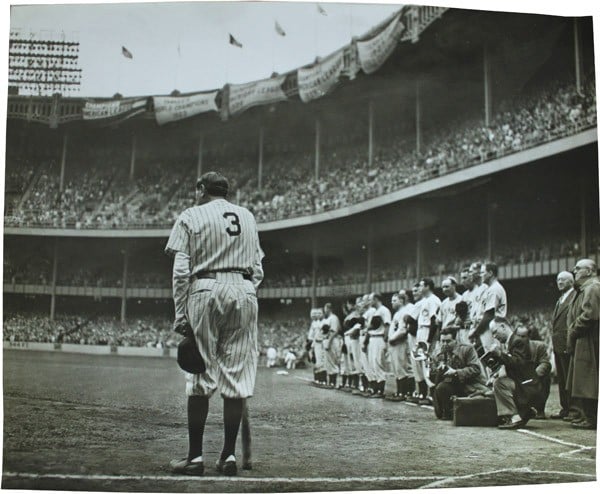Entitled “The Babe Bows Out”, the original image won a Pulitzer Prize, the first sports photograph ever to earn the prestigious honor. In 1999, LIFE magazine called it “one of the greatest pictures of the 20th century”. Copies reside in the collections of the Smithsonian Institution and the Baseball Hall of Fame.

The story of the photograph begins in the offices of the New York Herald-Tribune on June 13, 1948. Fein was a copy editor, but also knew his way around a camera. When a sports photographer called in sick, the 33-year-old Fein was dispatched to Yankee Stadium to capture images from the 25th anniversary of the House That Ruth Built. In addition to an exhibition featuring past members of the Yankees, The Babe himself was going to be honored with a jersey retirement ceremony. Fein hustled to the ballpark just in time.
Although the word ‘cancer’ was never spoken or written, Ruth was nearing the end of his life and it was obvious from his appearance that he was very sick. He put on the Yankee pinstripes with the aid of two men and after a brief photo session, he waited in the visitors’ dugout for his name to be called. The day was overcast and dank, unusual for June in New York, but fitting for such a painful moment. When it was time, Ruth shrugged off the overcoat that was keeping the chill away, and ambled up the dugout steps. He grabbed a nearby bat—one belonging, it turns out, to Bob Feller, the Cleveland Indians’ star pitcher now in the Hall of Fame, and made his way toward the third base side of home plate using the bat for support.
“He walked out into the cauldron of sound he must have known better than any other man,” wrote W.C. Heinz. Heeding the advice of his picture editor that “natural light catches the mood of the occasion”, Fein chose not to use a flashbulb. He set up behind Ruth, at a low angle and captured the legendary image. Fein avoided shooting Ruth’s tired face and shot from the back, the only place where the now-retired #3 was visible.
There are countless reasons why the photo has been reproduced (most without permission) and stands as one of the most memorable of all-time. Ruth is the largest figure in the photograph, but stands humbled by the giant stadium that he had helped fill so many times, by the realization of time passed and by the adoration of 49,641 fans who had come to cheer him for the last time.
Too ill to stay at the ballpark much longer, Ruth went into the clubhouse and sat down. He shared a beverage with former Yankee Joe Dugan who had just made an appearance in the old timers’ game. According to Robert W. Creamer’s biography, Ruth admitted to Dugan that he was “gone” and the two cried before The Babe was helped from the ballpark. He died two months later.
Shot with a bulky Speed Graphic camera purchased by his mother, the photo became known as “The Babe Bows Out”.
Nat Fein’s career at the Herald-Tribune continued until 1966 when the paper folded, but he continued working until his death in 2000 at age 86. He photographed presidents, European royalty and countless other notables throughout the 20th century, but the image of Babe Ruth’s final moment in Yankee Stadium is his most famous work.
No comments:
Post a Comment